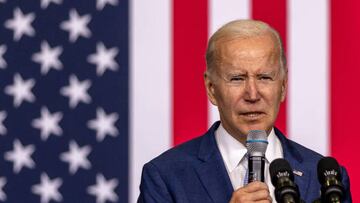Could $2 trillion in stimulus checks come back to haunt the Democrats in the 2022 midterm elections?
The GOP blames inflation on stimulus checks sent in 2021. Here is why most economists disagree with this criticism from the right.

With the 2022 Mid-Term elections just weeks away, the Republican Party is looking to make up ground against Democrats in many states. One easy target has been inflation, with many blaming the current cost of the living crisis on stimulus checks sent in 2021.
The idea that stimulus checks are driving the continued inflation in the market has been rejected by many top economists, including Nobel Prize winner Joseph Stegaliz.
For Stegaliz, unlike the GOP, inflation is not driven by increased effective demand, rather, “supply-side constraints drove inflation higher.” Stiglitz believes supply chains that broke down during the pandemic took longer to rebuild than many economists expected because of a general lack of “resilience” within the market economy.
Who could have foreseen that it would suffer critical shortages of baby formula, feminine hygiene products, and the components needed to produce new cars? Is this the United States or the Soviet Union in its dying days?
Stimulus checks increased demand while production remained constant
There is one way in which stimulus checks impacted market conditions that could have helped to explain short-term inflation. When direct payments were sent, consumption increased. However, production levels remained constant, meaning that there was increased demand and limited supply, which can lead to price increases as competition increases.
This would have helped to explain price increases in some markets like electronics and new and used cars. The global microchip shortage, which is expected to drag on through 2024, led to a rapid increase in the prices of goods that depend on these pieces of hardware. However, prices for electronics like cell phones and computers are down 3.6 and 16.1 percent, respectively, compared to this time last year. As supply chains were rebuilt and markets readjusted, prices came down. To argue that stimulus checks drove inflation would be to deny the decreases in prices tracked across industries where production was severely disrupted by the covid-19 lockdowns.
The areas where prices remain high, like food and energy, are seeing continued inflationary pressures. But this has little to do with demand. Demand for food and energy is relatively stable. When the government sent out a third stimulus check, perhaps some invested in a new cell phone, or car, or computer... people were not running to their supermarkets to buy out all of the broccoli or cereals.
To say that it is bad that more people were able to purchase food or cover their utility bills with their stimulus checks is nonsensical. The other option would have been to allow people to go hungry or have the government issues the benefits directly, which could have been more costly than sending a check to low and middle-class households.
What is going on in the energy and food markets?
As quarterly earnings reports begin to trickle out, it is becoming abundantly clear that corporations are using the geopolitical crisis in Ukraine to exploit consumers. If corporations really needed to increase prices to cover their inflated costs, we would not be seeing the record-breaking profits we currently are.
This issue is particularly prevalent in the energy sector, where oil and gas companies are raking in historic revenue but investing very little in capital expenditure to expand production. The US Energy Information Administration (EIA) even went so far as to report that in the first six months of 2022, petroleum production companies “allocated most of their cash to shareholder returns (share repurchases and dividends) and debt reduction.”
No members of the GOP are asking what the consequences of these financial decisions are having on the economy, particularly as the country approaches the winter months and energy consumption will increase as thermostats are turned up.
A hard winter is looming
When energy prices are high, the effect reverberates throughout the entire economy because the cost of transporting goods increases. Reining in inflation relies on reducing energy costs, and with companies making little investment to increase production, this winter may be hard as utility bills surge. The EIA expects household expenditure on natural gas to increase twenty-eight percent this winter.
Many households are asking where that money will come from, with savings having already decreased so significantly over the last year. Personal savings in the United States has hit lows unseen since the 2008 Financial Crisis. In August 2022, the Bureau of Economic Analysis tracked an average personal savings rate of 3.5 percent, down from 9.5 percent a year earlier. High inflation, particularly in food, energy, and housing markets, has eaten into the purchasing power of households across the country, and that helps to explain why savings has taken a nose dive. Low savings sends a strong warning that if economic conditions worsen, household resiliency will be tested in extremely concerning ways. If a strong recession does come and unemployment increases, these low levels of household savings will not be enough for many families to weather the economic storm.






